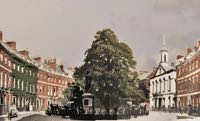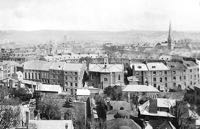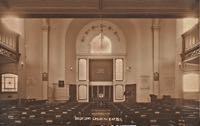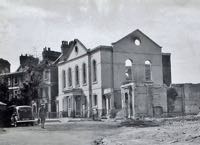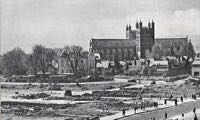
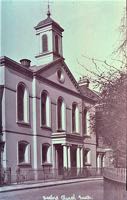 Bedford Chapel–Bedford Circus
Bedford Chapel–Bedford Circus
Page added 18th February 2018
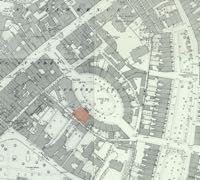 The beautiful, and lost Bedford Circus, occupied the site of a Dominican Friary, which, on the dissolution of the monasteries, became the town house of the Earls of Bedford. Building for the Georgian circus commenced in 1773, by Robert Stribling. Many developments of this type were speculative in nature, with a client purchasing the plot, and the builder allowing the client to design the rear, with a uniform frontage. Progress was slow, and it wasn’t until 1825 that the circus was completed. The complete development consisted of 13 Georgian houses facing another 9 opposite.
The beautiful, and lost Bedford Circus, occupied the site of a Dominican Friary, which, on the dissolution of the monasteries, became the town house of the Earls of Bedford. Building for the Georgian circus commenced in 1773, by Robert Stribling. Many developments of this type were speculative in nature, with a client purchasing the plot, and the builder allowing the client to design the rear, with a uniform frontage. Progress was slow, and it wasn’t until 1825 that the circus was completed. The complete development consisted of 13 Georgian houses facing another 9 opposite.
In 1828 plans were made to build a chapel in Bedford Circus to serve the inhabitants of Southernhay. A breach had been made in the city wall to connect Bedford Circus to Southernhay in 1814.
The site for the Bedford Chapel was in the centre of the block of nine houses, on the southern side of the Circus. Described as an Episcopal Chapel at the time, building commenced in 1831, on ground donated by the Duke of Bedford. At the time it was estimated that the central parishes of the city had a population of 12,000, and the churches of Holy Trinity, St Sidwell and St David’s enough seating for 2,400. The new chapel would add 900 places, of which, 300 would be free.
The chapel was the first church to be consecrated by the controversial Bishop Phillpotts, on 4 August 1832. As cholera was raging through Exeter that year, the Bishop had moved himself to Exmouth to escape, much to the disgust of the people. He duly arrived at the chapel in his four horse carriage, which was kept waiting at the door while he hurriedly went through a brief ceremony of consecration. At the conclusion, he jumped back into his carriage, which was driven away as fast as the four horses could haul it, and the doomed city was left to its fate.
The first rector of the chapel was the Rev William Scoresby. His scientific research, led to him figuring out how to correct the alignment of compasses in iron ships. He was also controversial in his politics, which appear to have been aligned to the Tories rather than the Whigs. He was criticised in one letter to the Western Times in 1837, about the content of a sermon, as this extract shows.
… I listened to the rev. gentleman's discourse, and alas sought in vain for that comfort which true Christianity alone can impart on such occasions. I was disappointed and distressed, for a more extraordinary tirade of toryism I never before heard delivered from the pulpit; almost every sentence carried with it a political point, and the policy of the Melbourne government was denounced with zeal …
Bedford Circus became known as the ‘bonnet shop’ due to fashionable ladies parading their hats. The Rev W Jackson, incumbent from about 1847 to 1851, when he retired due to ill health, lived up to the expected reputation of the area. He lived at No 2 Pennsylvania Park, and when he left the area in 1853, he had a grand sale of household items. Items for sale included 50 dozen rare old bottles of Port, Madeira, Claret, Hock, Burgundy, Shiraz and other wines. Many items were from the Palace of Fontainebleau, including marble ornaments, Oriental china and oil paintings.
In the 1870s, it closed for a time, a precursor for its decline in the 20th Century. In 1918, consideration was given to amalgamating the parish with St Martin, St Lawrence and St Stephen’s and the chapel be taken down. Throughout the 1920s and 30s, the viability of the chapel was questioned, as the city found itself with too many churches, and too few worshippers.
Under the incumbent, Rev. F S Ward, the chapel was attracting 200 for worship in 1930. The employment of the Rev. Ward was dependent on donations as there was no endowment. In 1931, closure was again considered, with the building being retained for another use. Although it had not been well constructed, it was considered to be a useful space.
So many histories of Exeter’s buildings end in May 1942, and the Bedford Chapel is no exception. On the morning of 5 May, Bedford Circus was badly damaged, along with Bedford Chapel. Hoskins thought the chapel could have been retained, but it was demolished in October 1946. The small congregation moved to worship at St Stephen’s Church in the High Street, despite it too having suffered blitz damage.
Sources: Reminiscences of Exeter Fifty Years Since by James Cossins, Discovering Exeter–Lost Churches by David Francis, Discovering Exeter–Pennsylvania, The British Newspaper Archive. ;
│ Top of Page │
